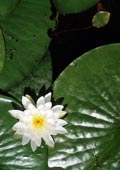Canoe Trips
Boundary Waters:
Boundary Waters Campsites
Bois Brule River
Flambeau River
Kickapoo and Mecan Rivers
Menonomee River
Sylvania Wilderness
Wisconsin's Flowages
Wolf and Peshtigo Rivers
Boats & Gear
Boundary Waters Gear List
Bell Wildfire (Royalex)
Blackhawk Ariel
Mad River Independence (sold)
Wenonah Prism (sold)
-cane seat
installation
-thwart replacement
Custom portage pads
Seat-mounted portage yoke
Outside canoe shelter
Inside canoe storage
Knots

|
Boundary
Waters Canoe Area Wilderness
Lake
One - Moose Lake Loop
June 9 - 20, 2014
Page
1: Overview
This
trip begins life as a loop from Moose River
North, through Lac La Croix, and out at Little Indian Sioux River,
starting in mid-May. That plan is interrupted by minor heart surgery
to correct atrial flutter (a relative of atrial fibrillation). It
turns out my tripping partner can't make it later, so I consider
a solo trip. Then I contact my friend, Jen-Shen, whom I'd met
by chance in the Seagull
Lake area in May of last year. It turns out he can adjust his own trip
plans to accommodate my schedule.
Note:
Each link opens in a new window.
The
Boats
This trip is what's called a "group solo," where
each person paddles a solo canoe. I provide the boats. One is a Bell
NorthStar tandem (16’6”,
kevlar skincoat with aluminum trim) with the bow and stern seats
removed and a cane seat installed behind the center thwart. Its portage
weight is 52 lbs. The other one is a Hemlock Peregrine solo (15'8",
kevlar/graphite/fiberglass with wood trim). With removable portage
yoke and a couple of tarp poles lashed into the stern, it weighs in
at 44 lbs. This trip is its maiden voyage.
The Gear
- Paddles: Bell/Mitchell 10-degree bent,
Sanborn Canoe custom Minnesota straight shaft, Grey Owl freestyle straight
shaft, Bending Branches Espresso ST (straight)..
- Shelters: Sierra Designs Zeta 2 tent (7 lbs.), Timberline
2 tent, CCS 10x12 tarp (3 lbs.), 6x8 lightweight poly tarp.
- Packs: Kondos
Outfitter Personal Canoe Pack (5,000 cu. in., 50
lbs.), a Sea
to Summit Hydraulic Dry Pack (65 liters, about 35
lbs.), a Knutsen Knu-Pac
II pack mounted on an NRS
Paragon Pack (4,800 cu. in., about 45 lbs.) and
two day packs (about 17 lbs. each).
- Water filter: Platypus CleanStream, Katadyn filtration
water bottle.
- Camera: Olympus TG-1 (waterproof); Jen uses a Canon
Powershot SX40.
- Cookset: Stainless steel nesting pots and bowls, Coleman
single-burner stove, Esbit solid fuel stove, and appropriate wind shields.
- New Balance Abyss OTB boots with SealSkinz knee-high
socks. Jen uses Muck boots (and his feet stay drier than mine).
The Food
Meals are pretty straightforward:
- Breakfast: granola with dried blueberries and
raisins, and a half-and-half mix of instant nonfat dry milk and Nido
Milk. Also a few scrambled egg meals with dehydrated mushrooms, tomatoes,
and onion.
- Lunch: beef jerky, bannock and trail mix.
- Dinners: Several Hawk
Vittles and Mountain House dehydrated meals
as well as a few homemade dehydrated meals. Dinners are accompanied
by Cache Lake fry bread with desserts of chocolate pudding and
a mix of Hungarian red wine and Chambord.
I use a BearVault 500 because of the beef jerky, trail
mix and granola, which are aromatic no matter how well they're sealed.
My dog ignores the Bear Vault when it's closed, but I wonder if a bear
would smell anything. I stash the food carefully at night and it's never
been disturbed, except one time when certain curious rodents investigated
a dry bag with trail mix in it.
The Map
A map of the area can be found here.
Leave the map open and you'll be able to follow along on each of the travel
days.
Campsite numbers are the ones painted on the latrines. The
figures in parentheses indicate the site numbers from this commonly-used
file: bwca-camp+port-wpt.gdb, located
at this site: http://w3.cs.jmu.edu/arch/hobbies/camp/maps/bwca/
Trip Statistics (you really want to know this):
| |
Total distance: |
48 mi. |
| |
Total time: |
26 hours |
| |
Portages: |
16 (736 rods, 2.3 mi.)
3 portages avoided due to high water |
| |
Portage-walking distance: |
2,208 rods (6.9 mi.) |
Trip
reports by day
Day 0 – Monday, June 9 – Through
the Portal Partly
I leave Stoughton, Wisconsin in time to pick up Jen at
the Duluth airport around 2:00, and the drive is uneventful - mostly.
About 20 miles from Ely we spot two moose feeding in the ditch on the other
side of the road, possibly a mother and calf. Shortly afterwards,
a pileated woodpecker flies across our path. Omens? I don't know about
that, but definitely impressive. We arrive at Voyageur North Outfitters
(VNO) at about 4:30. After checking into our bunkhouse and a quick
tour of Piragis' store we have dinner at The Chocolate Moose. Then we arrange
for tomorrow's shuttle and a tow back on our last day. We'll be exiting
at the south end of Moose Lake, which is about five miles long and oriented
to the prevailing southwest winds. If we were paddling tandem I wouldn't
worry about it, but solo boats have only one motor; a 20-mph wind
and foot-high waves make the going tedious, difficult and dangerous.
With those preparations in place we proceed to unpack
and repack our gear.
Days 1-3: Lake One to Lake Insula
Days 4-7: Lake Insula to Ima Lake
Days 8-11: Ima Lake to Moose Lake to Duluth
Back to top
|


